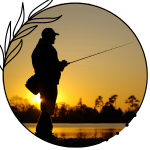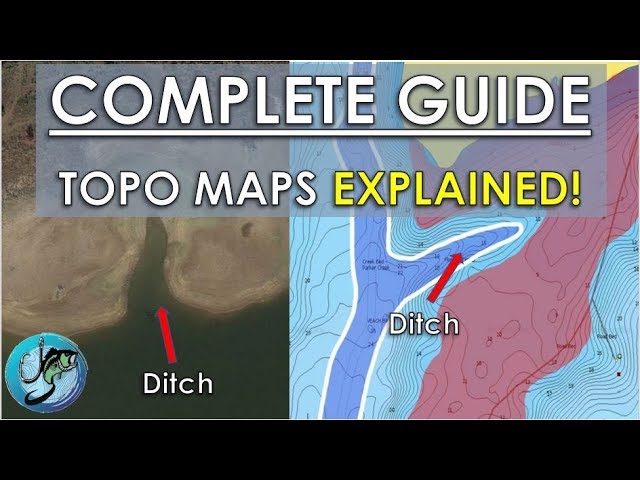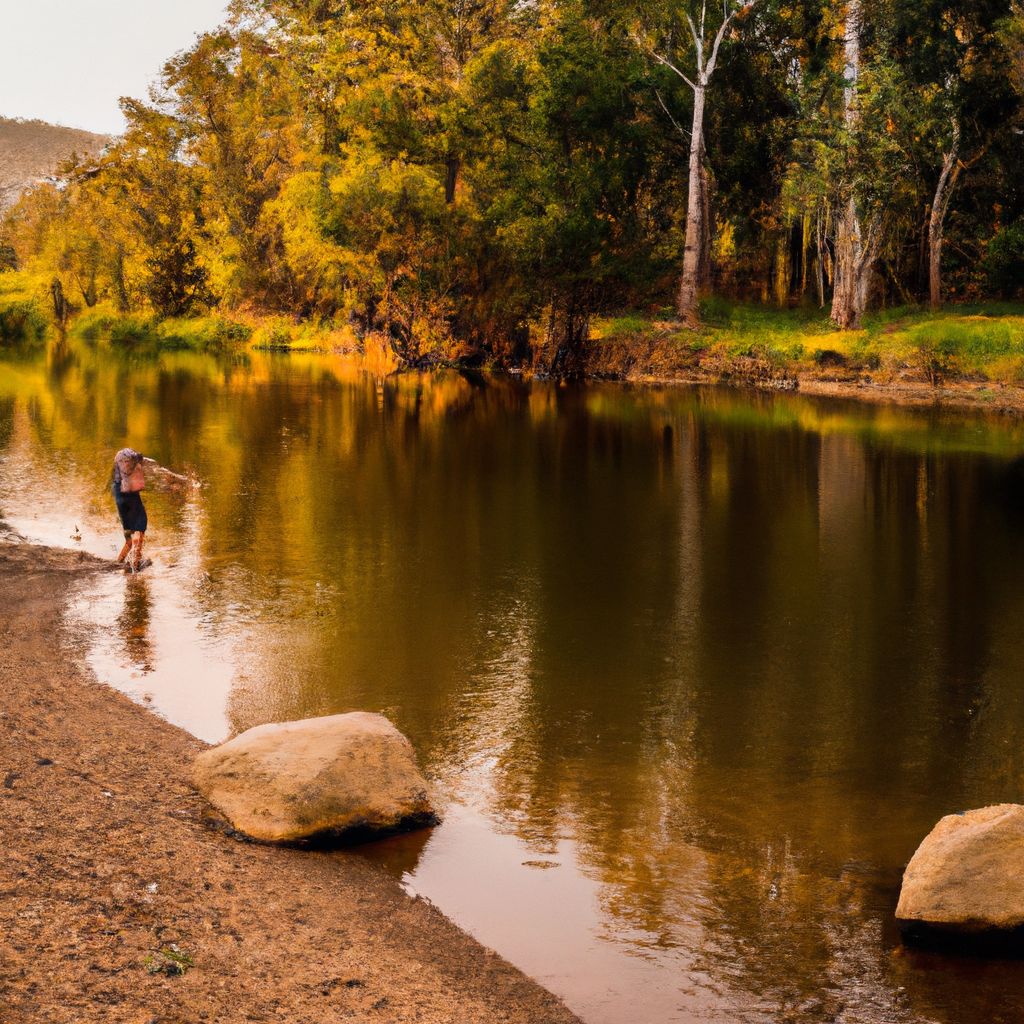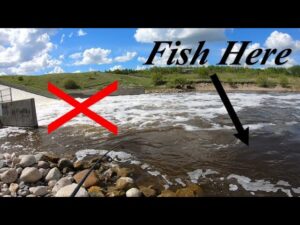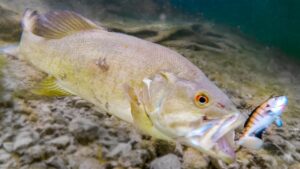Picture yourself standing on the peaceful shore of a river. Or, maybe you’re casting your line into the gentle depths of a lake. Where to start? How do you find the best fishing spots? Don’t be scared, fellow angler! Here, we’ll explore identifying the perfect spot for fishing in rivers and lakes.
To get the ideal fishing spot, there are some points to remember. Knowing fish behavior and their natural habitat is important. Notice the vegetation near the shore. Fish often take shelter near structures such as fallen trees or submerged rocks. Pay attention to water temperature and depth, too. It can have an effect on fish activity.
Let’s look at more details to make your fishing experience even better. Look out for clues, like ripples on the water surface. This could show that there are fish below. Predator fish usually stay near areas with prey, like shoals or drop-offs. Use bait and lures here, and you’ll have a better chance of getting a bite.
Pro Tip: Stay patient and watchful when looking for top fishing spots. Sometimes the best opportunities are right in front of you!
Now you have all this info, go off and catch the big one! Applying observation and considering fish behavior and structure will open up a world of possibilities in rivers and lakes. Finding these underwater hotspots is like unearthing buried treasure – without the pirates!
Understanding the Importance of Identifying the Best Fishing Spots
Importance of knowing the best fishing spots is key for a successful outing. Areas where fish are plentiful and active can increase chances of catching a great fish. How to determine these spots? Let us look at some points.
- It is must to know the habits and behavior of the target fish species. Different kinds of fish have their own habitat preferences. Some may like shallow waters with vegetation, while others may be found in deep sections or around submerged structures. This info will help to identify spots with potential.
- Secondly, availability of food sources is important. Fish like places with abundant prey items like insects, smaller fish, or crustaceans. Such areas are known to attract bigger predator fish, making them ideal for fishing.
- Thirdly, water temperature and clarity can also make a difference. Fish like areas where water conditions suit their needs. In warmer months, they look for cooler pockets of water or places with high oxygen levels. Clear water lets them spot prey easily and increases their feeding efficiency.
- On-the-ground knowledge and experience are essential. Experienced anglers use personal observations and local insights from fishing in rivers and lakes. They know about hidden structures, underwater currents, or seasonal changes that can influence fish behavior.
For example, Dave, a seasoned angler, shared his secret spot. It was a quiet cove with a large fallen tree, making it hard to spot. This obstacle channeled the river flow, creating an ideal ambush spot for predatory fish.
Finding the best fishing spot is like finding a true fishing buddy. It needs time, patience, and luck!
Factors That Influence the Quality of Fishing Spots
Fishing spots in rivers and lakes can be improved by a variety of factors. Let’s look at some of the main components that help make fishing a more successful experience.
- Water temperature, depth, underwater structures, currents and flow, and oxygen levels are all important.
- Additionally, food sources, spawning grounds, and underwater structures like drop-offs or channels can greatly improve your chances of a good catch.
- Plus, water clarity also influences the quality of fishing spots!
- Research conducted by the Fisheries Research Board of Canada shows that water clarity affects fish behavior and their ability to detect bait or lures.
- So, knowing how water clarity plays a role can really increase your success.
Different Types of Fishing Spots in Rivers and Lakes
To fathom the kinds of fishing spots, let’s look at the table below.
| Type of Fishing Spot | Description |
|---|---|
| Riverbank | An ideal spot for anglers. Offers access to deeper waters and home to various fish species. |
| River Confluence | Great spots as they have high concentration of fish. Two rivers merging is a plus. |
| Underwater Structures | Fallen trees and submerged rocks are shelters for fish. Exercise caution. |
| Weed Beds | Weed beds are magnets for small fish and big predator fish. Good for casting. |
| Deep Holes | Found in lakes and slow-moving rivers. Fish gather here during hot weather or to hide from predators. |
Also, conditions like weather and time of day influence the best spots. For example, in the early morning or late evening when the sun is not too bright, fish may be closer to the surface. On sunny days, fish may go deeper.
I have a story to illustrate this – last summer I was fishing at a lake known for its bass. After fishing for hours without success, I saw people near a fallen tree. I moved closer and cast my line there. Minutes later, surprise! I hooked onto a big bass! The fallen tree was a shelter and feeding spot for the bass, making it perfect for fishing.
Location is key for finding the best fishing spot, just like a good parking spot.
Identifying Fish Habitats and Behavior
It is essential to know the species of fish you are after. Different types of fish have different needs for their habitats. Some may like shallow waters near the shore, while others may be found in deeper areas or near structures like fallen trees or rocks. Researching the habits and habitat preferences of your desired fish species can help you focus your search.
Temperature is another factor to consider. Fish are sensitive to temperature changes and will look for areas with temperatures that suit them. Warmer water is usually found closer to the surface, and colder water tends to accumulate at greater depths.
Water clarity can affect how fish behave and where they live. Some fish prefer clear, clean waters with good visibility, while others live in murkier environments. Knowing the clarity of the water in lakes or rivers you want to fish in can give you clues to where the fish might be.
Also, pay attention to any signs of life around a potential fishing spot. Birds diving into the water or other aquatic animals like frogs or turtles can show that there are fish nearby. These creatures often eat smaller baitfish that attract bigger predators.
To help identify fish habitats and behavior, here is a table showing different factors that influence them:
| Factor | Description |
|---|---|
| Depth | Fish may prefer different depth levels depending on the species – shallow or deep waters |
| Temperature | Fish have specific temperature ranges they prefer; understanding these ranges helps identify suitable habitats |
| Structure | Fallen trees, rocks, submerged vegetation, etc., create hiding spots for fishes |
| Cover | Overhanging trees, docks, and vegetation provide shelter and protection for fish |
| Food | Fish will gather near areas with enough food sources like fish spawn, insects, or aquatic plants |
Though the table above gives a broad overview, there are still other factors to consider when identifying fish habitats. Such factors include water flow patterns, oxygen levels, and seasonal variations.
Izaak Walton, a famous angler, noticed that during winter months, pike would go into shallower waters near the riverbanks to stay warm. He used this to come up with successful techniques for catching pike in those areas.
Finding the best fishing spots requires careful observation and investigation. By considering factors such as depth, temperature, structure, cover, and food availability, you can improve your chances of finding fish in rivers and lakes. So, get your gear and explore nature’s underwater wonders!
Local Knowledge and Research for Finding the Best Fishing Spots
Gone fishing? Score the best spots in rivers and lakes with these 4 simple steps!
- Ask around: Talk to local fishermen and area experts for insider knowledge; they may know of gems not widely known.
- Surf the web: Look up fishing forums, websites, and social media groups for tips and maps.
- Look at maps and satellite imagery: Check out deep holes, submerged structures, and vegetated areas.
- Experiment and adapt: Test your findings with various techniques, lures, and baits, and adjust according to changing conditions.
Analyze the specifics of your chosen spot; don’t just rely on general tips. Oh, and here’s a fun fact: Fishbrain’s data shows that early morning hours before sunrise are the most productive time for freshwater fishing.
Go ahead and locate that elusive treasure chest – with the right techniques and tools, you’ll soon be reeling in more than fish!
Techniques and Tools for Identifying Promising Fishing Spots
Identifying the best fishing spots in rivers and lakes? It takes a combination of techniques and tools! These strategies can help you increase your productivity and get the most out of your fishing expeditions.
- Study Topographical Maps: Look for underwater structures like submerged reefs, points, or drop-offs that attract fish.
- Use Fish Finders: Sonar technology to detect and locate fish underwater. This device can show you data about the depth, temperature, and presence of fish.
- Observe Nature’s Clues: Look for signs like diving birds or jumping fish. These suggest areas with an abundance of baitfish.
- Talk to Local Anglers: Get insider tips on where to find the best action.
Other considerations: Water clarity, current flow, weather conditions, and time of day.
- Experiment with Different Baits: Different fish species have different bait preferences.
- Follow Moon Phases: Many anglers believe moon phases influence fish activity.
- Patience and Persistence: Fishing requires patience and persistence.
- Protect the Environment: Practice catch-and-release, adhere to fishing regulations, and clean up after yourself.
By using the right techniques, tools, and considerations, you can boost your chances of finding good fishing spots. With practice, you will become better at pinpointing these areas and maximizing your enjoyment of fishing!
Testing and Evaluating Fishing Spots
Fishing spots can be an art form to uncover. Here’s what to look for when assessing a potential spot:
- Water clarity: Clear water means a healthy ecosystem, upping the chances of fish. Look for good visibility.
- Structure: Fish love rocks, fallen trees, and underwater vegetation – they offer shelter and hiding places.
- Depth & currents: Different species prefer different depths and currents. Experiment with depths and watch the water movement.
- Temperature: Fish are sensitive to temperature changes, so monitor temps in different areas. They may gather in spots where temperatures fit their preference.
- Signs of life: Pay attention to signs of life like baitfish jumping or birds diving into the water. This tells you there are fish around, guiding you to possible hotspots.
Weather patterns also affect fishing spots. Rainfall can change water conditions. Wind direction may gather baitfish in certain areas, making predators come too.
Once upon a time, a pro angler discovered a hidden gem on a peaceful river’s bank. He studied maps and watched local anglers for hours before finding it. The spot was full of life – clear, cascading waters over rocks, lush greenery. He couldn’t resist casting his line and was rewarded with trout!
Word spread fast, and anglers from near and far went to this paradise. It became a popular destination for its fish and beauty.
The story of this spot proves the importance of testing and evaluating potential locations. With patience, observation, and a bit of intuition, anglers can uncover gems that offer unforgettable fishing experiences. So, go forth and explore the rivers and lakes! Happy fishing!
Factors to Consider for Different Seasons and Locations
Fishing in rivers and lakes requires knowledge of factors that vary depending on the season and location. To assist, a table has been created to highlight the important aspects for each season and location.
In spring, as the water temperature rises, it’s best to fish early in the morning. Summertime is ideal with warm water and clear skies. Fall fishing should take place late in the afternoon as cool breezes pick up. On those cold winter days, head out at midday when the water is cold and skies are overcast.
Location also matters. For instance, if fishing in a river during fall, late afternoon could bring more success. However, in a lake during winter, midday might be better.
My friend once fished a river in the fall and the late afternoon yielded a large catch of trout. He learned how important it is to consider both the season and location when planning a fishing trip.
Conclusion
Exploring the best fishing spots in rivers and lakes requires knowledge of various factors. Understanding water conditions, vegetation, and species can significantly increase your chances of success. Experienced fishermen watch fish behaviour to locate their hiding spots – underwater structures, like fallen trees and rocks, are often overlooked.
Weather patterns also need to be taken into account. Fish are more active under certain conditions, so use this knowledge to narrow down your search for productive spots.
Keep exploring and adapting your approach as populations and feeding habits change due to environmental factors. Be curious and don’t miss out on potential hotspots.
Go forth and cast your lines with patience and determination. Happy fishing!
Additional Resources and Tips for Finding the Best Fishing Spots
Searching for the ultimate fishing spot can be tricky but with the correct tips and resources, it can be easy. Here are some of those tips and resources to help you find the perfect spot in rivers and lakes.
- Local Fishing Guides: Talk to local fishing guides who know the place. They can give you good advice on where the fish are biting.
- Online Forums: Join online forums about fishing and meet experienced anglers. These are great sources of info about the best places to fish.
- Topographic Maps: Check out the topographic maps of the water you plan to fish in. Look for areas with structures like drop-offs, points or submerged vegetation, since these attract fish.
- Fishing Apps: Use fishing apps that have features like weather updates, GPS mapping and reports on hotspots. These apps can increase your success rate.
- Local Tackle Shops: Visit tackle shops in the area you want to fish. The staff usually know about productive spots and can recommend bait and tackle for that location.
- Nature Observation: Keep an eye out for natural signs like bird activity or surface ripples caused by feeding fish. These can direct you to good places.
It’s important to remember that each fishing spot is unique. Factors like weather, water temperature and fish behavior all affect where the fish will be. Be ready to adjust your approach based on these.
When looking for the best fishing spots in rivers and lakes, take your time. Give yourself enough time to explore different areas before settling in one spot. Remember, the best spots may not be obvious at first.
Pro Tip: Don’t only focus on popular fishing spots. Uncommon places or smaller bodies of water can give you hidden gems and a more enjoyable fishing experience.
